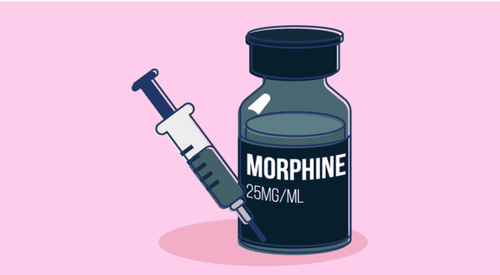This is an automatically translated article.
Morphine is a narcotic commonly used to relieve pain. The use of morphine in treatment requires a doctor's opinion to avoid risks and unwanted side effects.1. Why is Morphine Prescribed?
The use of opiates for pain relief has been used for a long time. Humans started using opium around 3500 BC. Through the ages, it has come to be known as a universal remedy.
In 1803, morphine was isolated from opium poppy, and it became one of the first drugs made from this plant. Morphine is popular and widely used for all types of pain relief. But one soon found its side effect of dependence on it.
Morphine and other narcotics have serious side effects. Therefore, it must be understood very well before giving it to the patient to minimize the risks that the patient may face.
According to the Centers for Disease Control and Prevention (CDC), about 11% of adults in the United States experience attacks of pain every day. Studies show that 10 to 60 percent of Americans undergo common surgeries and experience chronic pain after the procedures.
These pains affect their daily life and health. Morphine is used to relieve acute (immediate) and chronic (lasting) pain. However, morphine has serious side effects. Therefore, doctors will have to look very carefully every time they prescribe it, because the side effects that Morphine causes other health problems are very large.
There are four types of opioid receptors in several areas of the body. These include receptors in the brain, gastrointestinal (GI) tract, and spinal cord. In the brain, morphine helps release the neurotransmitter dopamine. This blocks pain signals and creates a pleasant sensation. Therefore, morphine acts as a pain reliever.
2. Types of morphine
Morphine is available in oral and injectable forms. Depending on the level of pain and safety for the patient, the doctor will decide which type to use. Today, the CDC has issued guidelines for the use of Morphine to safely and effectively manage chronic pain. This guide was developed specifically to help reduce the risk of opioid overdose and abuse.
2.1 Oral Morphine Oral Morphine is available in both immediate acting and long acting forms. For chronic pain, doctors often prescribe long-acting products. The doctor will decide which formulation and dosage is best by taking into consideration many factors, such as:
Patient's history with opioid medications Degree and type of pain Patient's age Health conditions other (kidney function, heart or lung problems, sleep apnea, low blood pressure, seizures, stomach problems, etc.) Other medications the patient is taking Other factors, such as sensitivity to morphine

Có thuốc morphine uống và thuốc morphine tiêm
2.2 Injectable morphine Injection Morphine injection is available as a solution that can be injected under the skin (subcutaneously), injected into a muscle (intramuscular), injected into a vein (intravenous). This type of morphine is to be administered only with medical supervision. Your doctor will choose a specific treatment and dosage based on your pain level and potential side effects. The injectable morphine has more risks than the oral version.
3. What are the short-term side effects of morphine?
The side effects experienced with the use of opiates such as morphine will depend on factors such as dose, strength and duration of use. The first time you start taking morphine, you may experience side effects.
Common short-term side effects of morphine such as nausea, vomiting, constipation, itching, loss of appetite, low body temperature, difficulty urinating, slow breathing, drowsiness, changes in heart rate, dizziness when standing up, feeling nervous, erectile dysfunction.
4. What are the long-term side effects of morphine?

Morphine có tác dụng gì?
Morphine is usually not the first choice for chronic pain because the risks of dependence and overdose are very serious. According to the CDC, 1 in 4 patients receiving long-term opioid treatment will develop an opioid use disorder.
Long-term use of morphine can cause side effects by disturbing the gastrointestinal tract, hormones and immune system and related gastrointestinal problems including: chronic constipation, loss of appetite, acid reflux. thick, flatulence, abdominal pain, dry mouth, weight loss.
Problems associated with hormonal changes include: increased blood sugar, problems with menstruation, osteoporosis and risk of fractures. Immune-related problems such as risk of infection, sexual dysfunction.
4.1. Tolerance If morphine is used for a long time, patients may need higher or more frequent doses to get the same pain relief.
If your body becomes tolerant to morphine, it does not mean that your body can tolerate other opiates. If doctors switch to another opioid, they must calculate a new dose to avoid an overdose. Do not change your dose without consulting your doctor.
Physical dependence: If you use morphine, your body may get used to it. You may not be able to function properly without morphine.
4.2 Opioid use disorder Opioids like morphine can be very strong. Some people may abuse morphine, like taking more than prescribed to increase these desired effects. They may start using the drug compulsively, even if it harms or interferes with their health, work, or relationships. This is opioid use disorder, or addiction.
Alcohol, marijuana, or other central nervous system depressants may increase the risk of overdose and other side effects. Do not drink alcohol or take other medications while using morphine.
4.4 Withdrawal Syndrome You cannot suddenly stop taking the drug if you have been using it for a while. Withdrawal effects can be serious and include: Anxiety, sweating, cravings, suicidal thoughts, trouble sleeping, depression, agitation, body aches, nausea and vomiting vomiting, diarrhea, cramps, moodiness, lack of concentration.
5. When to see a doctor
If your doctor prescribes morphine for you, be sure to tell your doctor if you have any side effects. Call your doctor or seek medical attention right away if you have symptoms such as: rash, fainting, trouble breathing, seizures, itching, swelling of the throat, swelling of the face, or swelling of the tongue.
6. Treatment of morphine side effects
One of the most unpleasant side effects of using morphine and other opioids is opioid-induced constipation. The study estimated that one-third of patients reduced their dose or stopped taking opioids altogether because of this side effect. Here are some ways to manage opioid-induced constipation:
Add fiber to your body through your diet Regular exercise. Drink more water. Use laxatives as needed. Take prescription medications, but consult your doctor to block opioid receptors in the gut, such as: Methylnaltrexone, Lubiprostone (Amitiza), naloxegol (Movantik), naldemedine (Symproic).

Nên tập thể dục thường xuyên nhằm tránh tác dụng phụ của Morphine
7. Treatment of overdose
There are risks to using morphine, including overdose. In some cases, an overdose can be fatal. In case of an emergency, get medical help right away if you suspect a morphine overdose. Signs of overdose include: slow breathing, extreme fatigue and unresponsiveness. While waiting for someone to help. Efforts should be made to keep the patient awake. People are at high risk of overdose if they have poor liver or kidney function, have sleep apnea emphysema, or use other medicines that increase the effects of morphine, such as benzodiazepines such as alprazolam. In some cases, a morphine overdose can be reversed with a medicine called Narcan or Evzio. These are the brand names of the drug naloxone. It blocks opioid receptors in the brain. If you have been using morphine for a long time, using naloxone can cause immediate withdrawal symptoms. If a person overdoses on long-acting morphine, they may need multiple doses of naloxone. Although management of morphine poisoning has been done, serious complications can still occur, even with naloxone.
Morphine is an effective opioid drug used to treat moderate to severe short and long term pain. The treatment with morphine needs to be agreed and consulted by the doctor to avoid the risks and have instructions for timely handling in bad situations.
Vinmec International General Hospital is one of the hospitals that not only ensures professional quality with a team of leading medical professionals, modern equipment and technology, but also stands out for its examination and consultation services. comprehensive and professional medical consultation and treatment; civilized, polite, safe and sterile medical examination and treatment space.
Please dial HOTLINE for more information or register for an appointment HERE. Download MyVinmec app to make appointments faster and to manage your bookings easily.
Article referenced source: healthline.com












